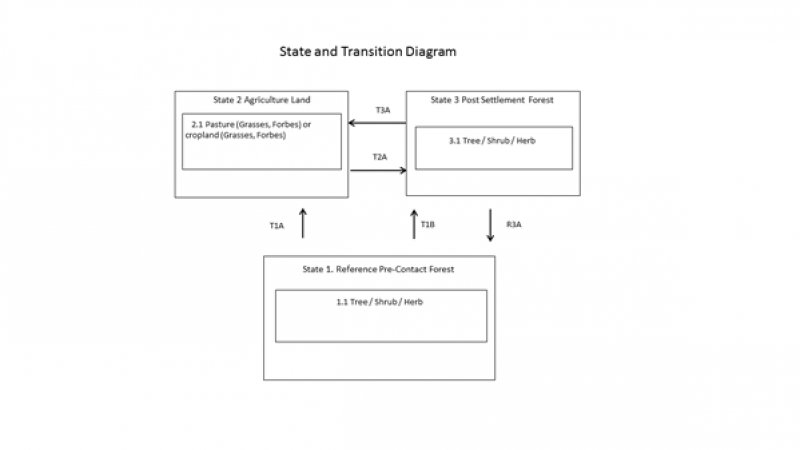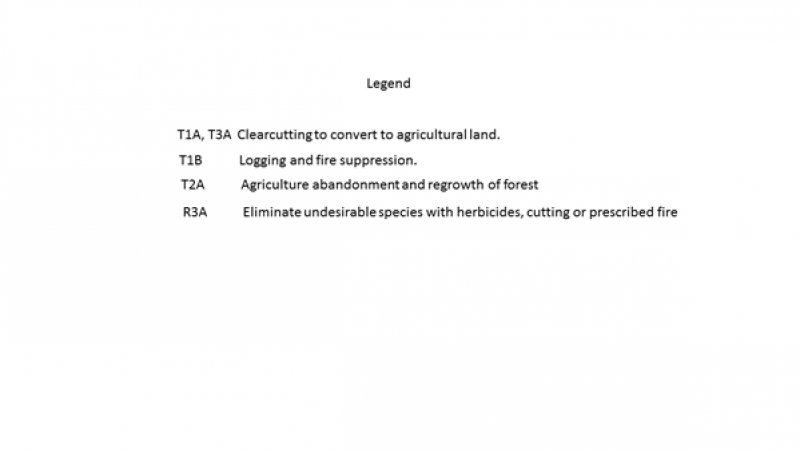
Natural Resources
Conservation Service
Ecological site F126XY002OH
Footslope
Last updated: 9/27/2024
Accessed: 12/22/2025
General information
Provisional. A provisional ecological site description has undergone quality control and quality assurance review. It contains a working state and transition model and enough information to identify the ecological site.
MLRA notes
Major Land Resource Area (MLRA): 126X–Central Allegheny Plateau
This ecosite is found on hills and plateau in MLRA 126. Steep slopes are dominant, but level to gently rolling plateau remnants are conspicuous in throughout the area. The area is dominantly forest, containing large blocks of state forest, game lands, and national forest. Less than one-tenth of the MLRA consists of urban areas.
This narrative was created from the Landfire Biophical Setiing (BpS) description
Classification relationships
USDA-NRCS (USDA 2006):
Land Resource Region (LRR): N—East and Central Farming and Forest Region
Major Land Resource Area (MLRA): 126—Central Allegheny Plateau
USDA-FS (Cleland et al. 2007)
Province: 221 - Eastern Broadleaf Province
Section: 221E - Southern Unglaciated Allegheny Plateau
Subsection: 221Ea - Pittsburgh Low Plateau
221Eb - Teays Plateau
221Ec - Ohio Valley Lowland
221Ed - East Hocking Plateau
This site crosswalks to Landfire biophysical setting (BpS) South-Central Interior Mesophytic Forest
NatureServe’s description (2007) for the equivalent ecological system CES 202.887 South-Central Interior Mesophytic Forest & CES 202.373 Southern and Central Appalachian Cove Forest
South-Central Interior Mesophytic Forest
Component Associations
Association Unique ID Association Name
CEGL002411 Fagus grandifolia - Acer saccharum - Liriodendron tulipifera Unglaciated Forest
CEGL004741 Acer saccharum - Carya ovata - Juglans nigra / Symphoricarpos orbiculatus / Galium circaezans Forest
CEGL004767 Tsuga canadensis - (Liriodendron tulipifera, Fagus grandifolia) / (Magnolia macrophylla, Ilex opaca) / Polystichum acrostichoides Forest
CEGL005043 Tsuga canadensis - Fagus grandifolia - Acer saccharum / (Hamamelis virginiana, Kalmia latifolia) Forest
CEGL005222 Liriodendron tulipifera - Tilia americana var. heterophylla - Aesculus flava - Acer saccharum / (Magnolia tripetala) Forest
CEGL006144 Quercus alba - Fagus grandifolia Western Allegheny Plateau Forest
CEGL006201 Acer saccharum - Liriodendron tulipifera - Fraxinus americana / Staphylea trifolia Forest
CEGL006237 Acer saccharum - Fraxinus americana - Tilia americana - Liriodendron tulipifera / Actaea racemosa Forest
CEGL007200 Fagus grandifolia Ridge and Valley Forest
CEGL007201 Fagus grandifolia - Liriodendron tulipifera / Euonymus americanus / Athyrium filix-femina ssp. asplenioides Forest
CEGL007213 Quercus alba - Fagus grandifolia / Hydrangea quercifolia - Viburnum acerifolium / Carex picta - Polystichum acrostichoides Forest
CEGL007220 Liriodendron tulipifera / (Cercis canadensis) / (Lindera benzoin) Ruderal Forest
CEGL007233 Quercus alba - Quercus rubra - Carya ovalis / Acer saccharum / Polystichum acrostichoides Forest
CEGL007698 Quercus rubra - Acer saccharum - Tilia americana var. heterophylla - Aesculus flava - (Cladrastis kentukea) Forest
CEGL007879 Juglans nigra / Verbesina alternifolia Ruderal Forest
CEGL007881 Fagus grandifolia - Quercus alba / Cornus florida Forest
CEGL008428 Quercus alba - (Liriodendron tulipifera, Liquidambar styraciflua) / Calycanthus floridus / Athyrium filix-femina Forest
CEGL008488 Quercus rubra - Tilia americana var. heterophylla - Carya carolinae-septentrionalis / Acer (barbatum, leucoderme) / Hydrangea quercifolia Forest
Southern and Central Appalachian Cove Forest
Component Associations
Association Unique ID Association Name
CEGL004293 Impatiens (capensis, pallida) - Monarda didyma - Rudbeckia laciniata var. humilis Herbaceous Vegetation
CEGL004296 Diphylleia cymosa - Saxifraga micranthidifolia - Laportea canadensis Herbaceous Vegetation
CEGL004982 Betula alleghaniensis - Tilia americana var. heterophylla / Acer spicatum / Ribes cynosbati / Dryopteris marginalis Forest
CEGL006186 Liriodendron tulipifera - Quercus rubra - Fraxinus americana / Asimina triloba / Actaea racemosa - Uvularia perfoliata Forest
CEGL006237 Acer saccharum - Fraxinus americana - Tilia americana - Liriodendron tulipifera / Actaea racemosa Forest
CEGL006304 Liriodendron tulipifera - Pinus strobus - Tsuga canadensis - Quercus (rubra, alba) / Polystichum acrostichoides Forest
CEGL006472 Tilia americana var. heterophylla - Aesculus flava - Acer saccharum / Cystopteris bulbifera - Asarum canadense Forest
CEGL007102 Pinus strobus - Tsuga canadensis / Rhododendron maximum - (Leucothoe fontanesiana) Forest
CEGL007136 Tsuga canadensis / Rhododendron maximum - (Clethra acuminata, Leucothoe fontanesiana) Forest
CEGL007220 Liriodendron tulipifera / (Cercis canadensis) / (Lindera benzoin) Ruderal Forest
CEGL007233 Quercus alba - Quercus rubra - Carya ovalis / Acer saccharum / Polystichum acrostichoides Forest
CEGL007291 Liriodendron tulipifera - Tilia americana var. heterophylla - (Aesculus flava) / Actaea racemosa Forest
CEGL007543 Liriodendron tulipifera - Betula lenta - Tsuga canadensis / Rhododendron maximum Forest
CEGL007693 Tsuga canadensis - Halesia tetraptera - (Fagus grandifolia, Magnolia fraseri) / Rhododendron maximum / Dryopteris intermedia Forest
CEGL007695 Aesculus flava - Acer saccharum - (Fraxinus americana, Tilia americana var. heterophylla) / Hydrophyllum canadense - Solidago flexicaulis Forest
CEGL007710 Liriodendron tulipifera - Fraxinus americana - (Tilia americana, Aesculus flava) / Actaea racemosa - Laportea canadensis Forest
CEGL007711 Tilia americana var. heterophylla - Fraxinus americana - (Ulmus rubra) / Sanguinaria canadensis - (Aquilegia canadensis, Asplenium rhizophyllum) Forest
CEGL007878 Quercus rubra - Tilia americana var. heterophylla - (Halesia tetraptera var. monticola) / Collinsonia canadensis - Prosartes lanuginosa Forest
CEGL008407 Tsuga canadensis - (Fagus grandifolia, Tilia americana var. heterophylla) / Magnolia tripetala Forest
CEGL008412 Acer (nigrum, saccharum) - Tilia americana / Asimina triloba / Jeffersonia diphylla - Caulophyllum thalictroides Forest
CEGL008510 Liriodendron tulipifera - Quercus rubra - Magnolia acuminata / Cornus florida Forest
CEGL008512 Tsuga canadensis - Quercus prinus - Liriodendron tulipifera / Kalmia latifolia - (Rhododendron catawbiense) Forest
Ecological site concept
These sites generally occur on uplands with MAAT > 45 degree F. These lands are typically concave surface morphomentry
From Landfire http://www.landfire.gov/index.php:
Geographic Range
The mixed-mesophytic forest region (Küchler 1964) is located in two of Bailey’s ecoregion sections (McNab and Avers 1994). It includes the southern portion of the Southern Unglaciated Allegheny Plateau Section (southeastern OH, western West VA, northeastern KY). It also covers the Northern Cumberland Plateau Section (eastern KY and east-central TN; and southern Blue Ridge ecoregion, and a very small portion in northeast AL and northwest GA). There are also scattered occurrences in northwestern and central PA (C.E. Williams, G. Nowacki personal communication). In the southern limits of this forest type, one might find this more restricted to more northerly aspects.
These high-diversity, predominately deciduous forests occur on deep and enriched soils (in some cases due to, or enhanced by, the presence of limestone or related base-rich geology), usually in somewhat protected landscape positions such as coves or lower slopes. The core distribution of this system lies in the Cumberland and Allegheny plateaus, extending into the adjacent southern Ridge and Valley and portions of the Interior Low Plateau where it is located entirely south of the glacial boundary.
Biophysical Site Description
Mixed mesophytic forests occur on moist, topographically protected areas (e.g. coves, v-shaped valleys, N and E facing toe slopes) within highly dissected hills and mountains. On slopes it forms a mosaic with pyrogenic oak-hickory forests, whereby mixed mesophytic forests are restricted to the most protected coves and oak-hickory occurs on the interfluves. These Plateaus are mature and dissected, most of the landscape consisting of high hills and narrow valleys. Elevations range from 650 to 1,300ft in the Allegheny Plateau and from 1,270 to 2,000ft in the Cumberland Plateau (McNab and Avers 1994). The dissected topography creates strong gradients in microclimate and soil moisture and fertility at the local (watershed) scale (Hutchins et al. 1976, Iverson et al. 1997, Morris and Boerner 1998). In the absence of frequent or catastrophic disturbance, these environmental gradients determine forest composition (Hutchins et al. 1976, Muller 1982, Iverson et al. 1997, Dyer 2001).
These forests occupy the transition zone from the oak-hickory forest to the northern hardwood forest. They are among the most diverse in the US containing more than 30 canopy tree species. This type lies west of the Appalachians and transitions from the more northern sugar maple-beech-birch forest in northern West VA, southwestern PA (lesser extent in northwestern and central PA), and southern OH southward down the Allegheny Mountains, across the Allegheny Plateau including all of the Cumberland Plateau, and into northern AL where it transitions to the oak-hickory-pine type of the Southern Mixed Hardwood Forest (Brown et al. 2000). Two major and distinct forest types within this BpS are typically recognized: mixed-oak and mixed-mesophytic. This model focuses on the mixed-mesophytic type.
Associated sites
| F126XY004OH |
Side Slope Side Slopes |
|---|
Table 1. Dominant plant species
| Tree |
(1) Acer saccharum |
|---|---|
| Shrub |
(1) Actaea racemosa |
| Herbaceous |
Not specified |
Click on box and path labels to scroll to the respective text.

